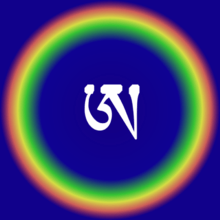Bindu (symbol)
Bindu (Sanskrit: बिंदु) is a Sanskrit word meaning "point" or "dot". A bindi is a small, ornamental, devotional dot applied to the forehead in Hinduism.[1][2]
Philosophy
In metaphysics, Bindu is considered the point at which creation begins and may become unity. It is also described as "the sacred symbol of the cosmos in its unmanifested state".[3][4] Bindu is the point around which the mandala is created, representing the universe.[5]
Bindu is often merged with [seed] (or sperm) and ova. In the Yoga Chudamani Upanishad Bindu is a duality, with a white Bindu representing shukla (sperm) and a red Bindu representing maharaj (menses). The white Bindu resides in the bindu visarga and is related to Shiva and the Moon, while the red Bindu resides in the muladhara chakra and is related to Shakti and the Sun.[6] In yoga, the union of these two parts results in the ascension of kundalini to the sahasrara.[7]
Chakra
| Tantric chakras |
|---|
|
Sahasrara |

In Tantra, Bindu (or Bindu visarga—"falling of the drop") is a point at the back of the head where Brahmins grow their tuft of hair.[8][9] This point is below the sahasrara chakra and above the ajna chakra, and is represented by a crescent moon with a white drop. It represents the manifestation of creations such as consciousness.[10]
The Bindu visarga is said to be the source of Bindu fluid, which contains a nectar (amrita) and a poison.[11] The fluid is released from the Bindu visarga, and can be stored in the lalana chakra and purified in the Vishuddha chakra. When the Vishuddha is inactive the fluid flows to the manipura chakra, where it is consumed (leading to physical decline). According to the Hatha Yoga Pradipika, a hatha yoga practitioner can prolong their life by controlling the flow of the fluid.[12] Through practice of Khecari mudra, a practitioner can manipulate the flow of the fluid from the lalana to the Vishuddha (where it is purified to amrita).
The picture of the chakra is a lotus with 23 petals. Its symbol is the moon, which supports the growth of vegetation. Krishna said in the Bhagavad Gita XV/13, "Becoming the nectarine moon I nourish all plants". Its divinity is Shiva, who is portrayed with the crescent moon in his hair.
The Bindu chakra is a centre for health, giving us the power for physical and mental recuperation. It benefits eyesight, quietens the emotions and promotes inner harmony, clarity and balance. With the help of this chakra we are capable of controlling hunger and thirst, gaining the ability to overcome unhealthy eating habits. Concentration on Bindu relieves anxiety and depression, nervousness and feelings of oppression in the heart.[13]

In Tibetan Buddhism Bindu refers to the subtle body, which is composed of drops (Tibetan: ཐིག་ལེ thig le) and winds (Tibetan: རླུང rLung).[14]
See also
- Bindudham temple
Notes
- ↑ Khanna 1979: p.171
- ↑ Swami Ranganathananda (1991). Human Being in Depth: A Scientific Approach to Religion. SUNY Press. p. 21. ISBN 0791406792.
- ↑ Khanna 1979: p.171
- ↑ Swami Ranganathananda (1991). Human Being in Depth: A Scientific Approach to Religion. SUNY Press. p. 21. ISBN 0791406792.
- ↑ Shakya, p. 82-83
- ↑ Saraswati, p. 144
- ↑ Kumar, p. 94
- ↑ Saraswati, p. 21
- ↑ Kumar, p. 8-9
- ↑ Saraswati, p. 143
- ↑ Saraswati, p.141-142
- ↑ Hatha Yoga Pradipika
- ↑ http://www.yogaindailylife.org/esystem/yoga/en/180700/chakras/bindu-chakra/
- ↑ http://studybuddhism.com/web/en/archives/e-books/unpublished_manuscripts/developing_balanced_sensitivity/pt5/sensitivity_17.html Grasping at Mind's Natural Functions for Security. Alexander Berzin
References
- Khanna, Madhu (1979). Yantra: The Tantric Symbol Of Cosmic Unity. Thames and Hudson.
- Kumar, Ravindra (2000). Kundalini for Beginners: The Shortest Path to Self-Realization. Llewellyn Worldwide.
- Rana, Deepak (2012). Yantra, Mantra and Tantrism: The Complete Guide. Neepradaka Press.
- Saraswati, Satyananda (1996). Kundalini Tantra. Bihar School of Yoga.
- Shakya, Milan (June 2000). "Basic Concepts of Mandala." Voices of History, Vol. XV, No. 1. pp. 81–87